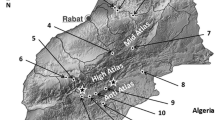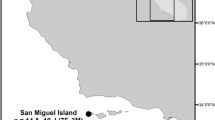Abstract
Turtles are useful for studying bioaccumulative pollutants such as mercury (Hg) because they have long life spans and feed at trophic levels that result in high exposure to anthropogenic chemicals. We compared total Hg concentrations in blood and toenails of three species of turtles (Chelydra serpentina, Sternotherus odoratus, and Graptemys geographica) with different feeding ecologies from locations up- and downstream of a superfund site in Virginia, USA. Mercury concentrations in turtle tissues were low at the reference site (average ± 1SE: blood = 48 ± 6 ng g−1; nail = 2,464 ± 339 ng g−1 FW) but rose near the contamination source to concentrations among the highest ever reported in turtles [up to 1,800 ng g−1 (blood) and 42,250 ng g−1 (nail) FW]. Tissue concentrations remained elevated ~130 km downstream from the source compared to reference concentrations. Tissue Hg concentrations were higher for C. serpentina and S. odoratus than G. geographica, consistent with the feeding ecology and our stable isotope (δ13C and δ15N) analyses of these species. In addition, we suggest that toenails were a better indication of Hg exposure than blood, probably because this keratinized tissue represents integrated exposure over time. Our results demonstrate that downstream transport of Hg from point sources can persist over vast expanses of river thereby posing potential exposure risks to turtles, but relative exposure varies with trophic level. In addition, our study identifies turtle toenails as a simple, cost-efficient, and minimally invasive tissue for conservation-minded sampling of these long-lived vertebrates.





Similar content being viewed by others
References
Albers PH, Sileo L, Mulhern BM (1986) Effects of environmental contamination on snapping turtles of a tidal wetland. Arch Environ Contam Toxicol 15:39–109
Barr JF (1986) Population dynamics of the common loon (Gavia immer) associated with mercury-contaminated waters in northwestern Ontario. Canadian Wildlife Service Occasional paper no. 56
Bearhop S, Waldron S, Thompson D, Furness R (2000) Bioamplification of mercury in great skua Catharacta skua chicks: The influence of trophic status as determined by stable isotope signatures of blood and feathers. Mar Pollut Bull 40:181–185
Bearhop S, Furness R, Hilton GM, Votier SC, Waldron S (2003) A forensic approach to understanding diet and habitat use from stable isotope analysis of (avian) claw material. Funct Ecol 17:270–275
Bergeron CM, Husak JF, Unrine JM, Romanek CS, Hopkins WA (2007) Influence of feeding ecology on blood mercury concentrations in four species of turtles. Environ Toxicol Chem 26:1733–1741
Bergeron CM, Bodinof CM, Unrine JM, Hopkins WA (2010a) Mercury accumulation along a contamination gradient and nondestructive indices of exposure in amphibians. Environ Toxicol Chem 29:980–988
Bergeron CM, Bodinof CM, Unrine JM, Hopkins WA (2010b) Bioaccumulation and maternal transfer of mercury and selenium in amphibians. Environ Toxicol Chem 29:989–997
Bergeron CM, Hopkins WA, Todd BD, Hepner MJ, Unrine JM (2011) Interactive effects of maternal and dietary mercury exposure have latent and lethal consequences for amphibian larvae. Environ Sci Technol 45:3781–3787
Bonzongo JC, Lyons WB, Hines ME, Warwick JJ, Faganeli J, Horvat M, Lechler PJ, Miller JR (2002) Mercury in surface waters of three mine-dominated river systems: Idrija River, Slovenia; Carson River, Nevada; and Madeira River, Brazilian Amazon. Geochem Explor Environ Anal 2:111–119
Carter LJ (1977) Chemical-plants leave unexpected legacy for two Virginia rivers. Science 198:1015–1020
Congdon JD, Greene JL, Brooks RJ (2008) Reproductive and nesting ecology of female snapping turtles. In: Steyermark AC, Finkler MS, Brooks RJ (eds) Biology of the Snapping Turtle (Chelydra serpentina). Johns Hopkins University Press, Baltimore, pp 123–134
Cristol DA, Brasso RL, Condon AM, Fovargue RE, Friedman SL, Hallinger KK, Monroe AP, White AE (2008) The movement of aquatic mercury through terrestrial food webs. Science 320:335
Day RD, Christopher SJ, Becker PR, Whitaker DW (2005) Monitoring mercury in the loggerhead sea turtle, Caretta caretta. Environ Sci Technol 39:437–446
DeNiro MJ, Epstein S (1978) Influence of diet on the distribution of carbon isotopes in animals. Geochim Cosmochim Acta 42:495–506
Drevnick PE, Sandheinrich MB (2003) Effects of dietary methylmercury on reproductive endocrinology of fathead minnows. Environ Sci Technol 37:4390–4396
Eisler R (2006) Mercury hazards to living organisms. CRC Press, Boca Raton
Ernst CH, Lovich JE, Barbour RW (1994) Turtles of the United States and Canada. Smithsonian Institute Press, Washington, DC
Evers DC, Kaplan JD, Meyer MW, Reaman PS, Braselton WE, Major A, Burgess N, Scheuhammer AM (1998) Geographical trend in mercury measured in common loon feathers and blood. Environ Toxicol Chem 17:173–183
Evers DC, Burgess NM, Champoux L, Hoskins B, Major A, Goodale WM, Taylor RJ, Poppenga R, Daigle T (2005) Patterns and interpretation of mercury exposure in freshwater avian communities in northeastern North America. Ecotoxicology 14:193–221
Gibbons JW, Scott DE, Ryan TJ, Buhlmann KA, Tuberville TD, Metts BS, Greene JL, Mills T, Leiden Y, Poppy S, Winne CT (2000) The global decline of reptiles, déjà vu amphibians. Bioscience 50:653–666
Golet WJ, Haines TA (2001) Snapping turtles (Chelydra serpentina) as monitors for mercury contamination of aquatic environments. Environ Monit Assess 71:211–220
Hallinger KK, Cornell KL, Brasso RL, Cristol DA (2011) Mercury exposure and survival in free-living swallows (Tachycineta bicolor). Ecotoxicology 20:39–46
Hammerschmidt CR, Sandheinrich MB, Wiener JG, Rada RG (2002) Effects of dietary methylmercury on reproduction of fathead minnows. Environ Sci Technol 36:877–883
Heinz GH (1996) Mercury poisoning in wildlife. In: Fairbrother AL, Locke LN, Hoff GL (eds) Noninfectious diseases of wildlife, 2nd edn. Iowa State University Press, Ames, pp 118–127
Heinz GH, Hoffman DJ, Klimstra JD, Stebbins KR, Kondrad SL, Erwin CA (2009) Species differences in the sensitivity of avian embryos to methylmercury. Arch Environ Contam Toxicol 56:129–138
Helwig DD, Hora ME (1983) Polychlorinated biphenyl, mercury, and cadmium concentrations in Minnesota snapping turtles. Bull Environ Contam Toxicol 30:186–190
Hildebrand SG, Strand RH, Huckabee JW (1980) Mercury accumulation in fish and invertebrates of the North Fork Holston River, Virginia and Tennessee. J Environ Qual 9:393–400
Hill WR, Stewart AJ, Napolitano GE (1996) Mercury speciation and bioaccumulation in lotic primary producers and primary consumers. Can J Fish Aquat Sci 53:812–819
Hobson KA, Clark RG (1993) Turnover of 13C in cellular and plasma fractions of blood: implications for nondestructive sampling in avian dietary studies. Auk 110:638–641
Hobson KA, Clark RG (1994) Assessing avian diets using stable isotopes I: turnover of 13C in tissues. Condor 94:181–188
Hopkins WA (2006) Use of tissue residues in reptile ecotoxicology: a call for integration and experimentalism. In: Gardner S, Oberdorster E (eds) New perspectives: toxicology and the environment, vol 3., Reptile toxicologyTaylor and Francis Publishers, London, pp 35–62
Hopkins WA (2007) Amphibians as models for studying environmental change. Inst Lab Anim Res J 48:270–277
Hopkins WA, Rowe CL (2010) Interdisciplinary and hierarchical approaches for studying the effects of metals and metalloids on amphibians. In: Sparling D, Linder G, Bishop CA (eds) Ecotoxicology of amphibians and reptiles, 2nd edn. SETAC Press, Pensacola, pp 325–336
Hopkins WA, Roe JH, Snodgrass JW, Jackson BP, Kling DE, Rowe CL, Congdon JD (2001) Nondestructive indices of trace element exposure in squamate reptiles. Environ Pollut 115:1–7
Hopkins WA, Snodgrass JW, Baionno JA, Roe JH, Staub BP, Jackson BP (2005) Functional relationships among selenium concentrations in the diet, target tissues, and nondestructive tissue samples of two species of snakes. Environ Toxicol Chem 24:344–351
Hopkins WA, Hopkins LB, Unrine J, Snodgrass J, Elliot J (2007) Mercury concentrations in tissues of osprey from the Carolinas, USA. J Wildl Manage 71:1819–1829
Iverson JB (1982) Biomass in turtle populations—a neglected subject. Oecologia 55:69–76
Jackson BP, Hopkins WA, Baionno JA (2003) Laser ablation-ICP-MS analysis of micro-dissected tissue: a conservation-minded approach to assessing contaminant exposure. Environ Sci Technol 37:2511–2515
Kenyon LO, Landry AM, Gill GA (2001) Trace metal concentrations in blood of the Kemp’s Ridley sea turtle (Lepidochelys kempii). Chelonian Conserv Biol 4:128–135
Meyers-Schöne L, Walton BT (1994) Turtles as monitors of chemical contaminants in the environment. Rev Environ Contam Toxicol 135:93–153
Meyers-Schöne L, Shugart LR, Beauchamp JJ, Walton BT (1993) Comparison of two fresh-water turtle species as monitors of radionuclide and chemical contamination—DNA-damage and residue analysis. Environ Toxicol Chem 12:1487–1496
Mitchell JC (1994) The reptiles of Virginia. Smithsonian Institute Press, Washington, DC
Obbard ME (1980) Nesting migrations of the snapping turtle (Chelydra serpentina). Herpetologica 36:158–162
Post DM (2002) Using stable isotopes to estimate trophic position: models, methods, and assumptions. Ecology 83:703–718
Rimmer CC, McFarland KP, Evers DC, Miller EK, Aubry Y, Busby D, Taylor RJ (2005) Mercury concentrations in Bicknell’s thrush and other insectivorous passerines in montane forests of northeastern North America. Ecotoxicology 14:223–240
Scheuhammer AM, Meyer MW, Sandheinrich MB, Murray MW (2007) Effects of environmental methylmercury on the health of wild birds, mammals, and fish. Ambio 36:12–18
Sokal RR, Rohlf FJ (1995) Biometry: principles and practice of statistics in biological research. W.H. Freeman, New York
Southworth GR, Peterson MJ, Bogle MA (2004) Bioaccumulation factors for mercury in stream fish. Environ Pract 6:135–143
Tan SW, Meiller JC, Mahaffey KR (2009) The endocrine effects of mercury in humans and wildlife. Crit Rev Toxicol 39:228–269
Thompson DR, Furness RW (1989) The chemical form of mercury stored in South Atlantic seabirds. Environ Pollut 60:305–317
Turnquist MA, Driscoll CT, Schulz KL, Schlaepfer MA (2011) Mercury concentrations in snapping turtles (Chelydra serpentina) correlate with environmental and landscape characteristics. Ecotoxicology 20:1599–1608
USEPA (1991) Determination of mercury in tissues by cold vapor atomic absorption spectrometry. EPA/600/4-91/010
USEPA (2002) Method 1631, Revision E: Mercury in water by oxidation, purge and trap, and cold vapor atomic fluorescence spectrometry. EPA-821-R-02-019
Vander Zanden MJ, Rasmussen JB (2001) Variation in δ15N and δ13C trophic fractionation: Implications for aquatic food web studies. Limnol Oceanogr 46:2061–2066
Wada H, Cristol DA, McNabb FMA, Hopkins WA (2009) Suppressed adrenocortical responses and triiodothyronine levels in tree swallow (Tachycineta bicolor) nestlings near a Hg-contaminated river. Environ Sci Technol 43:6031–6038
Watras CJ, Bloom NS (1992) Mercury and methylmercury in individual zooplankton—implications for bioaccumulation. Limnol Oceanogr 37:1313–1318
Wiener JG, Spry DJ (1996) Toxicological significance of mercury in freshwater fish. In: Beyer WN, Heinz GH, Redmon-Norwood AW (eds) Environmental contaminants in wildlife: interpreting tissue concentrations. Lewis Publishers, Boca Raton, pp 297–340
Wolfe MF, Schwarzbach S, Sulaiman RA (1998) Effects of mercury on wildlife: a comprehensive review. Environ Toxicol Chem 17:146–160
Young-Morgan & Associates (1990) An assessment of mussel communities in the North Fork Holston River. Prepared for: Olin Corporation, pp 1–22
Acknowledgments
J. Schmerfeld, G. Heffinger, K. Tom, M. Newman, D. Evers, D. Yates, G. Schoenholtz, and S. Folsom provided valuable assistance during the project. We thank the landowners along the NFHR for their cooperation. Collection of animals was in conformance with appropriate permits in Virginia and Tennessee and sample methods were in compliance with Virginia Polytechnic Institute and State University’s animal care and use protocols. This research was primarily supported by contract #501817M754 from the US Fish and Wildlife Service, but was also supported by startup funds to WAH.
Conflict of interest
The authors declare that they have no conflicts of interest.
Author information
Authors and Affiliations
Corresponding author
Rights and permissions
About this article
Cite this article
Hopkins, W.A., Bodinof, C., Budischak, S. et al. Nondestructive indices of mercury exposure in three species of turtles occupying different trophic niches downstream from a former chloralkali facility. Ecotoxicology 22, 22–32 (2013). https://doi.org/10.1007/s10646-012-0999-8
Accepted:
Published:
Issue Date:
DOI: https://doi.org/10.1007/s10646-012-0999-8




